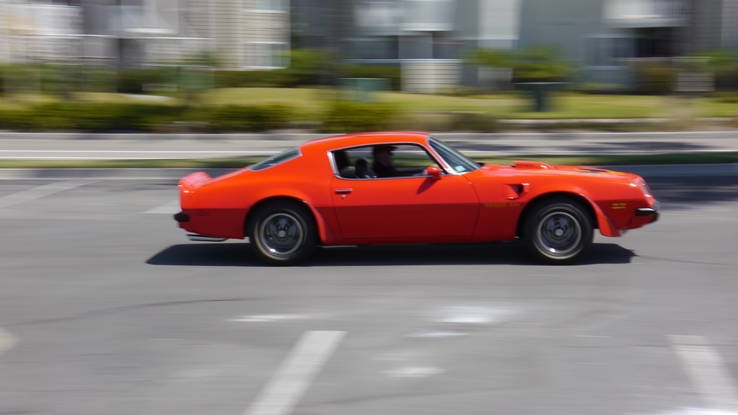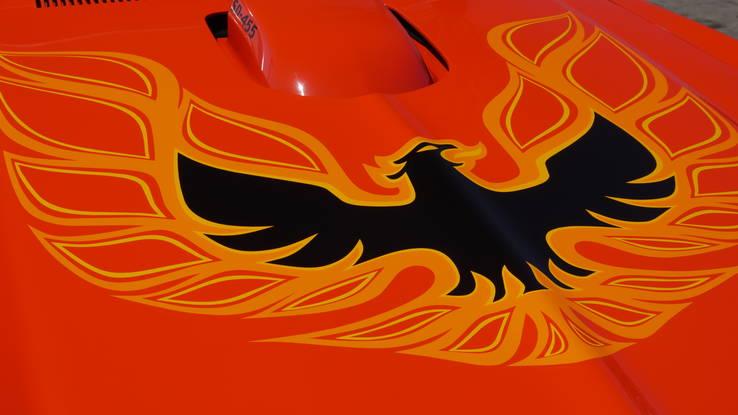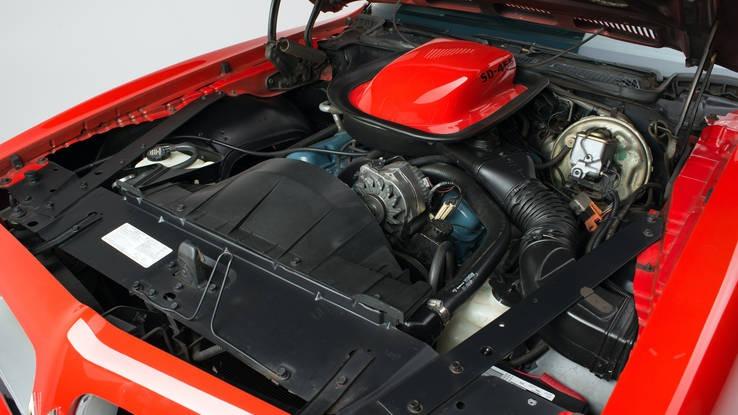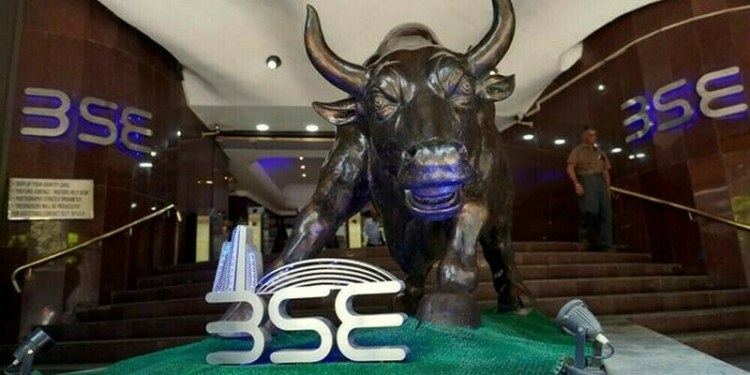The last of the original muscle car era, anyway: a 1974 Pontiac Trans Am Super Duty 455
Stick your head inside this 1974 Trans Am and you know what it smells like? High school.
Craig Jackson graduated from high school in 1977. By then, of course, the muscle car era was dead and buried and we were all wallowing around in Pintos and Datsun B210s. But the Trans Am we got to drive, the one you see here, was still a muscle car, the last muscle car. It was like the last buffalo, only faster and with 395 lb-ft of torque.
“The muscle car era stretched as late as 1974 because of one car,” wrote Barrett-Jackson’s Steve Statham.
This was that car.
“This is the end of the era,” said Craig Jackson, mashing the throttle on the Trans Am on an unnamed Southern California highway, the grand beast rising on its haunches, roaring its terrible roar. “…until modern muscle cars.”

Jackson drives the Super Duty like Rockford through a beach parking lot.
But rather than bid farewell to the era, you can still root around here and there – on Craigslist, eBayMotors, AutoTrader and at any of a thousand swap meets all over the world – and find great, grizzled, still-going dinosaurs like this one. And you can drive them. That’s what we were doing, the result of a meeting with Jackson at Pebble Beach, where we said we thought it’d be “…a great idea to drive something fun.” Jackson suggested this car, probably because Craig Jackson loves muscle cars more than almost anything else in the world –- and because they’re going to sell it Sept. 26 in Las Vegas and the more people know about it the more money everybody’ll make off it.
Craig Jackson got some of his love of muscle cars from his dad Russ Jackson, of course, who was the original Jackson in Barrett-Jackson Auctions.
“I was just lucky I grew up around a lot of great muscle cars,” said Craig, mashing more throttle and grabbing more gears, having more fun than perhaps a responsible 56-year-old should. “I grew up around Tom Barrett, who had all the world’s great classics, and my dad with the classics he had, and I learned restoring cars on those. My dad really liked Figoni et Falaschi, Delahayes and Talbot Lagos and V16 Cadillacs. He worked at Fisher Body at General Motors and went to GM Tech. And I was born in Pontiac. So I always liked Pontiacs.”

The Screaming Chicken
Roooooaaaaarrrr! Blip, blip, squeal! Roar, roar, roar!
Having an older brother helped, too.
“He was 14 years older,” said Craig. “Babysitting, for my brother, was taking me to Beeline Dragway, where he won the Winternationals in ‘65 in Super Stock; he raced SCCA so we used to go to Riverside, Stardust Raceway and watch him race; and cruising Central (Avenue) in Phoenix. So I spent a lot of time in the back seat of muscle cars as he went and did things. And I’ve always loved them.”
This one is almost perfect, in a lot of ways, for Craig Jackson.
If only it was a ’73 it’d be perfect.
“I’m gonna buy a ’73,” he said. “I like Super Dutys.”
Indeed, even with its smog equipment, the ’74 in Super Duty trim still has the feel of a genuine muscle car.
“You don’t get the same horsepower that you got in ’73. These had an 8.5:1 compression ratio, so to really get the horsepower you gotta rev it more. When the secondaries on the Quadrajet kick in you feel it. It’s got a forged crank, forged pistons, TRW forged pistons in it, so it’s got all the good internals, it’s just that it’s a smog motor. It’s the only way they could make any horsepower.”
But they still made some, 290 net hp, which was 65 more than the standard, non-Super Duty 400-cubic-inch V8 and 40 more than the regular, also non-Super Duty 455. There was also 395 lb-ft of torque, all of which really made the car get up and go, as we found out when it was our turn to drive.

The heart of the beast – the Screaming Chicken heart.
The key that starts this big bruiser just seems too small to be effective, but it works – turn it and the big block bolts to life. Push the long clutch pedal way down to the floor, search around a little for first gear and then whammo, you’re off. With so much torque it’s easy to break the rears loose, but it’s not uncontrollable. You can squeal the tires loudly or just make a little squeak. We squealed a little just because we could.
“Go ahead,” Jackson said when a long, dragstrip-like stretch emptied out and opened up before us – and so we did.
The engine roars but it’s not an abusive roar; the front end rises and the car starts to float around a little. You have to pay attention to the whole process. In that regard it’s probably safer to drive a car like this, which is fully engaging, than a more modern car that does everything for you. People look, they like, they give the thumbs up. One guy asks if “…that’s the Smokey and the Bandit car.” Jackson tells him it’s a few model years early.
Through stop-and-go traffic the temp gauge stayed at 180 degrees, a temperature Jackson said he sees in traffic in Phoenix, too.
A few more open stretches, a few more good, fun launches. We could take this to Beeline Dragway, we think, if only Beeline Dragway still existed. It doesn’t; neither does Stardust Racewway, but this car does. It will go on the block at no reserve. Jackson figures it’ll easily sell for six figures. It’s a clean car, everything is just as we remember cars in that era. And while six figures may seem like a lot of money, it’s pretty cheap for a time machine.
Anyone want to go back?




























